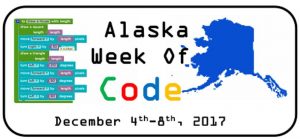What is coding?
Simply put, ‘coding’ is giving instructions to computers to do something. It is what makes it possible for us to create computer software, apps and websites. Your internet browser, the apps on your phone, Facebook, and this website – they’re all made with code, by people who code.
Why learn coding?
Computer science informs almost every aspect of our lives, from communications to shopping to national security and government. Coding is the basic foundation of computer science, and an area that every public school can benefit from teaching. And the best thing is that ANYONE can learn to code.
Learn from the Experts
How to participate in The Alaska Week of Code
Our goal is simple: Introduce more Alaskan students to coding! Check out the following links for fast and easy ways to get you or your students coding today:
- Coding Activities (by grade level) – A great place to start!
- Hour of Code for all Ages – An overview of the Hour of Code Program
- Hands-on Exploration of Computer Science – A list of fun hands-on activities, with links
Going beyond The Alaska Week of Code
- Extended Courses on computer science
- Girls Who Code Clubs
- Beyond the Hour of Code
- Everyone Can Code (Apple)
- Made With Code (Google)
- Micro:bit
- Sphero Education
Register your school’s participation! Let’s fill up the Alaska map!
Show your work!
Let us know on social media how your class, school, district is participating with the hashtags #AlaskaWeekOfCode and #aklearns.
